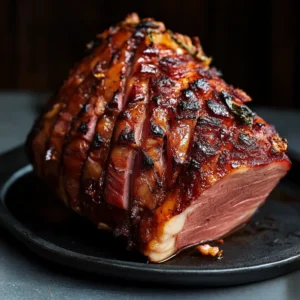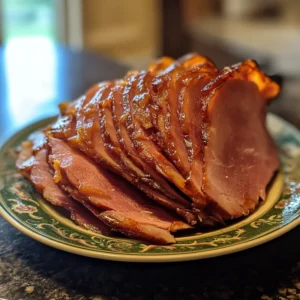1. Introduction

Smoked ham is a culinary delight cherished for its rich, smoky flavor and tender texture. Whether you’re a seasoned chef or a home cook, mastering the art of smoking ham can elevate your dishes to a new level. This article will guide you through the process of creating perfectly smoked ham, from preparation to serving, with tips, tricks, and expert insights along the way.
2. Ingredients
List of Ingredients
To start, you’ll need high-quality ham, a brine mixture, and your choice of seasoning. Essential ingredients include:
- Ham (bone-in or boneless)
- Salt
- Sugar
- Water
- Your favorite spices and herbs
Best Types of Ham for Smoking
The type of ham you choose can affect the final flavor and texture. Options include:
- Bone-in ham for added flavor
- Boneless ham for easier slicing
3. Preparation
Preparing the Ham
Start by rinsing the ham and patting it dry. Trim any excess fat, if necessary.
Brining the Ham
Brining is crucial for flavor and moisture. Mix salt, sugar, and spices with water, and immerse the ham for 5-7 days in the refrigerator.
Seasoning and Flavoring
After brining, season the ham with your preferred rub or glaze. Common choices include a mixture of brown sugar, paprika, and garlic powder.
4. Smoking Equipment
Essential Tools and Equipment
You’ll need a smoker, wood chips, and a meat thermometer. Ensure your smoker is clean and functioning properly.
Choosing the Right Smoker
Options include electric, charcoal, and pellet smokers. Each type has its pros and cons, so choose based on your preference and experience level.
Wood Types and Their Impact
Different woods impart unique flavors. Popular choices are hickory, applewood, and mesquite. Experiment to find your favorite combination.
5. Smoking Process
Step-by-Step Smoking Instructions
Preheat your smoker to 225°F. Place the ham in the smoker and cook until it reaches an internal temperature of 145°F, typically 4-6 hours.
Temperature and Time Recommendations
Maintain a steady temperature throughout the smoking process. Adjust as necessary to ensure even cooking.
Tips for Even Smoking
Use a water pan in the smoker to maintain moisture. Rotate the ham occasionally for even flavor distribution.
6. Post-Smoking
Checking for Doneness
Use a meat thermometer to check the internal temperature. The ham should reach 145°F for safe consumption.
Resting and Slicing

Let the ham rest for 15-20 minutes before slicing. This helps retain its juices.
Storing Leftovers
Wrap any leftover ham tightly in plastic wrap and refrigerate. It can be used in a variety of recipes.
7. Serving Suggestions
Side Dishes That Pair Well
Smoked ham pairs beautifully with dishes like roasted vegetables, mashed potatoes, and green beans.
Serving and Presentation Ideas
Serve sliced ham on a platter with garnishes such as fresh herbs or fruit slices for an attractive presentation.
8. Variations and Tips
Different Flavor Profiles
Experiment with various rubs and glazes to create different flavor profiles. For a spicy kick, try adding chili powder to your seasoning mix.
Common Mistakes and How to Avoid Them
Avoid overcooking by monitoring the temperature closely. Ensure the smoker is properly preheated before adding the ham.
Expert Tips and Tricks
Consult with experienced smokers or chefs for additional tips on achieving the perfect smoke ring and flavor.
9. Health Considerations
Nutritional Information
Smoked ham is a good source of protein but can be high in sodium. Be mindful of portion sizes.
Healthier Alternatives
Consider using a low-sodium brine or opting for leaner cuts of ham.
10. Expert Insights
Quotes from Smokers or Chefs
“Smoking ham is both an art and a science. The key is to balance the smoke with the meat’s natural flavors.” – [Expert Name]
Case Studies or Success Stories
Highlight success stories from amateur and professional smokers who have perfected their smoked ham recipes.
11. Future Outlook
Emerging Trends in Smoking
Explore new trends such as dry-aging or using unique wood blends for innovative flavor profiles.
Innovations in Smoked Ham Recipes
Keep an eye on emerging techniques and recipes that enhance the traditional smoked ham experience.
12. Conclusion
In summary, smoking ham is a rewarding process that combines technique with creativity. By following these steps and experimenting with different flavors, you can create a delicious and memorable dish. Ready to try it yourself? Gather your ingredients, fire up the smoker, and enjoy the process of crafting the perfect smoked ham.
Internal Linking Opportunities
For additional cooking inspiration, check out these related recipes:
External Links
Learn more about the best smoking techniques and wood choices for optimal flavor:
Conclusion
This smoked ham recipe is sure to become a staple in your cooking repertoire. By following the steps outlined and utilizing the tips provided, you can create a flavorful and juicy ham that will impress your family and friends. Enjoy the process of smoking and the delicious results that come from it!
FAQs
Q1: How long should I smoke a ham?
A1: Smoke the ham for approximately 1.5 to 2 hours, or until it reaches an internal temperature of 140°F (60°C).
Q2: What type of wood is best for smoking ham?
A2: Applewood and cherrywood are excellent choices for smoking ham, providing a mild, sweet flavor. Hickory and mesquite offer a stronger, more intense smokiness.
Q3: Can I use a different glaze for my ham?
A3: Absolutely! Feel free to experiment with different glazes. Some popular alternatives include pineapple glaze or a brown sugar and bourbon glaze.
Q4: How do I store leftover smoked ham?
A4: Store leftovers in an airtight container in the refrigerator for up to 5 days. For longer storage, freeze the ham in a freezer-safe container for up to 6 months.

